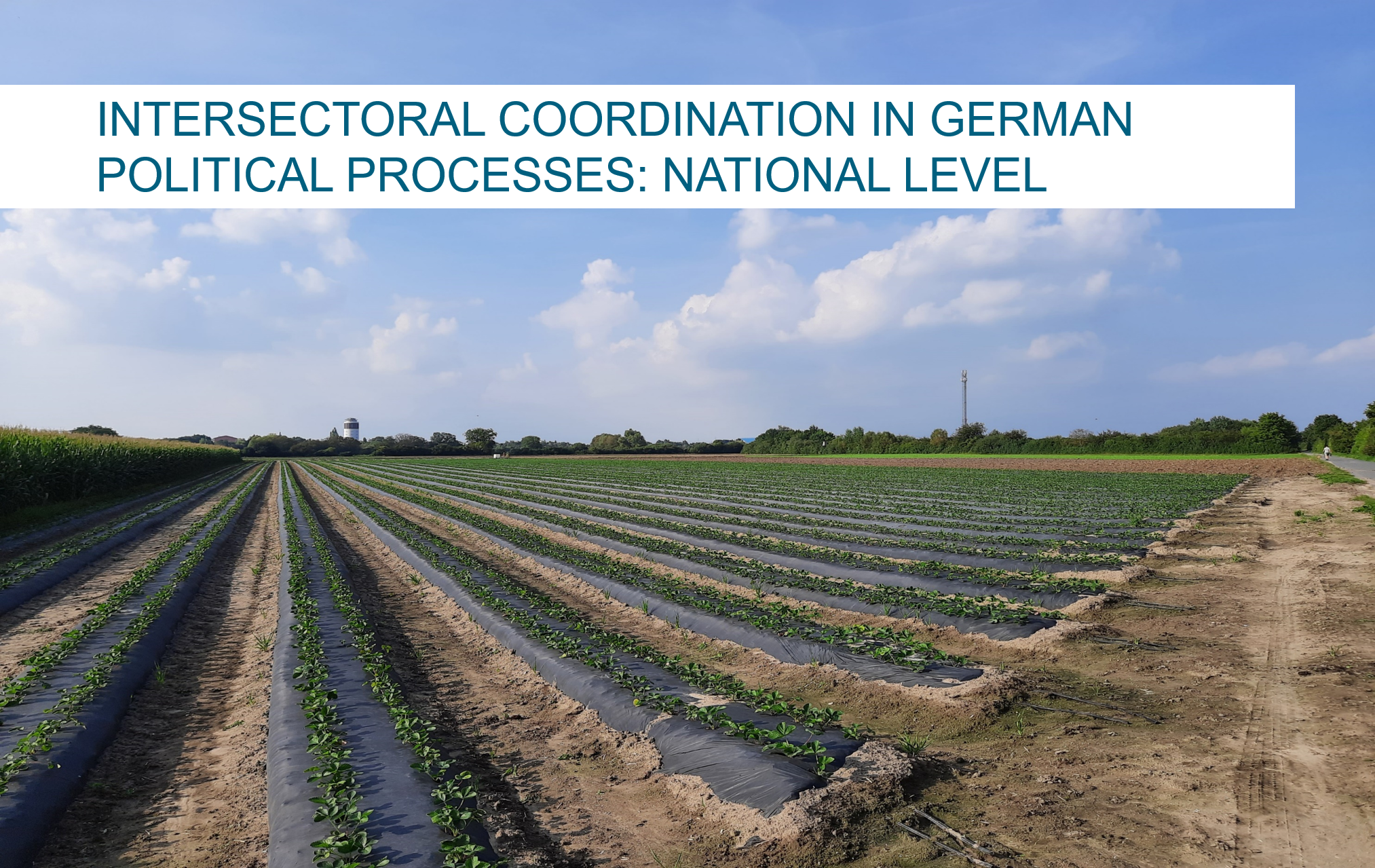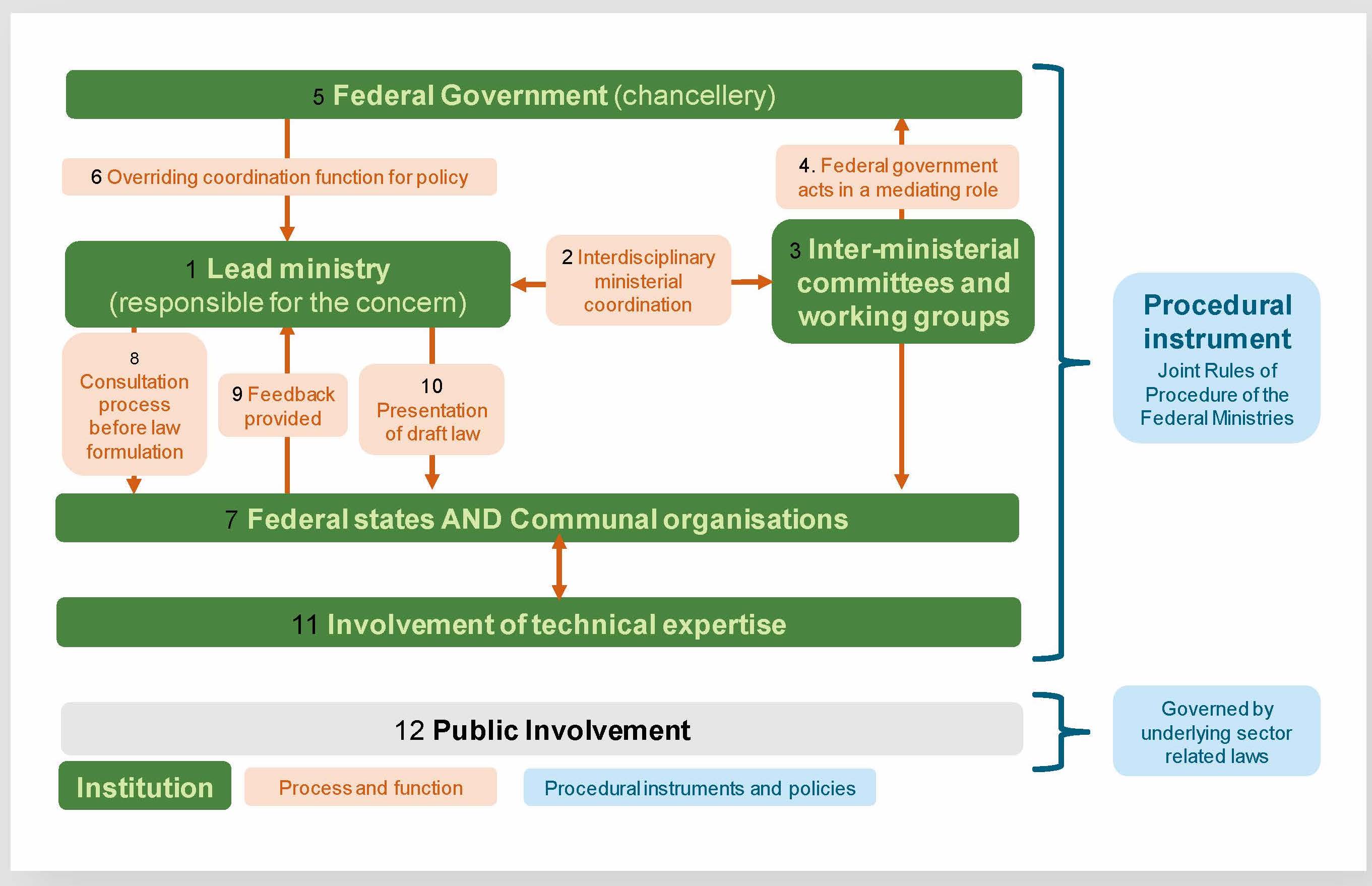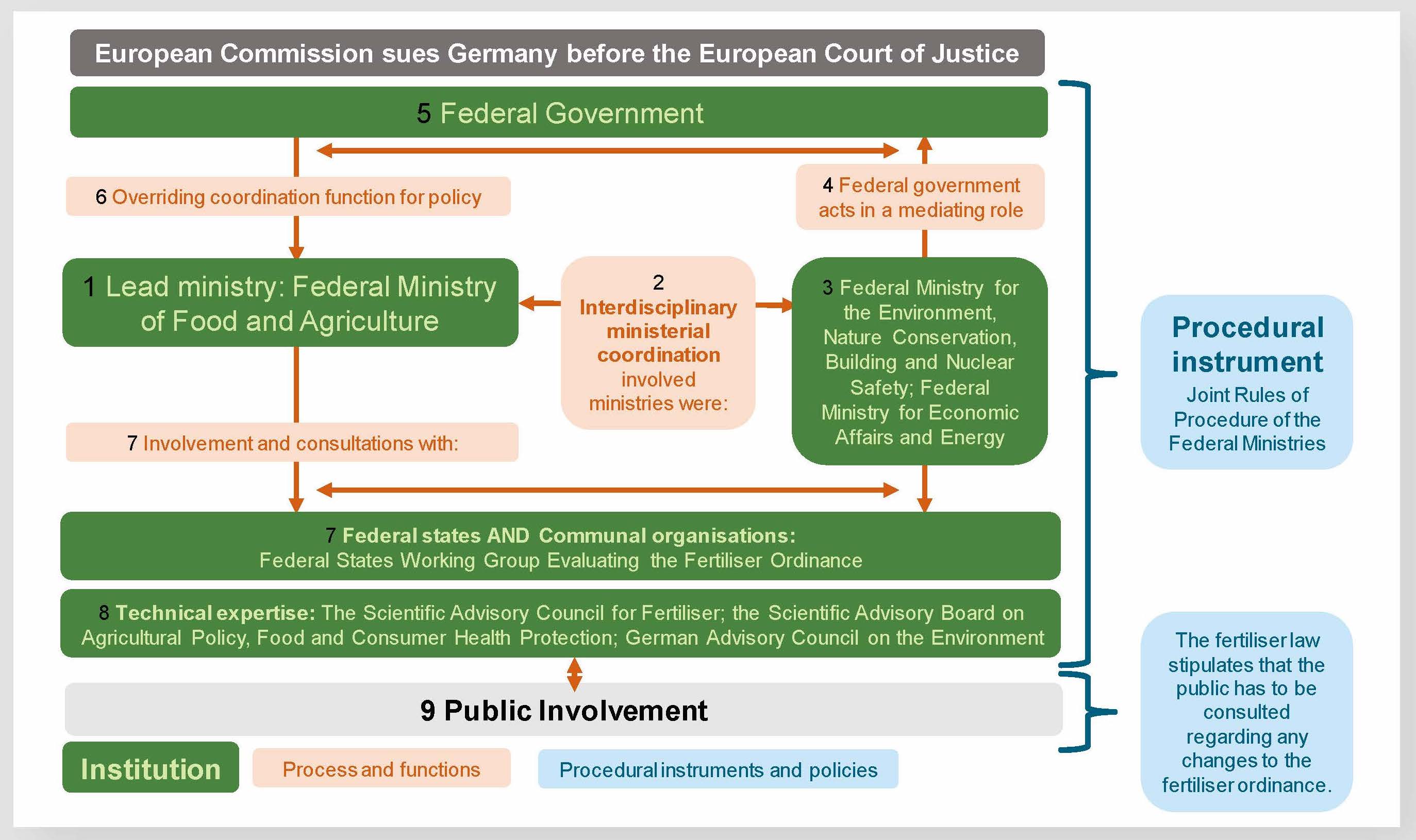6.3.1 Case Study I - Fertiliser Ordinance Amendment in Germany

1. Introduction
The WEF-Nexus governance may take place at different scales (global, regional, national, local or at farm or household level e.g. when farmers optimize their resources use through implementing adequate technologies).
The case study “Fertiliser Ordinance Amendment in Germany” demonstrates examples of governance instruments for intersectoral coordination at national scale in Germany. The case study represents two instruments:
- a procedural instrument: integrated decision-making process at the national level in Germany through Joint Rules of Procedure of the Federal Ministries AND
- an organizational instrument: working groups of ministries representatives
2. Intersectoral coordination in German political processes
Objective: Explain the intersectoral coordination in German political process

The process takes place in the following order (numbers from 1 to 12 on the diagram):
Inter-ministerial horizontal coordination:
- The lead ministry responsible for a matter (introduction of a new law, plan) must inform other affected ministries about his plans and is
- principally responsible for the management of the cooperative work.
- Many formal and informal institutions exist that help achieve this coordination between different ministries and disciplines. The main formal institutions for horizontal coordination between the ministries are inter-ministerial committees and working groups.
- When disputes arise, the responsible ministry is not permitted to take any binding decisions. Instead, the issue must be negotiated until an agreement is reached. The Federal Government has two functions in this process: It acts in a mediating role if the ministries cannot reach an agreement. Only when all points of conflict are resolved a definitive decision will be taken.
- Furthermore, the federal government assumes the responsibility for the overriding coordination of policy
- Involvement of the federal states and communal organizations (horizontal and vertical coordination):
- The lead ministry must also involve federal states and communal organizations in the legislative process.
- In the first step, the views of federal states and communal organizations must be obtained (GGO, Article 41, 44).
- The federal states and communal organizations provide their position statements.
- As soon as a draft law is formed, the ministry will present the draft to the states and the communal organizations.
- The involvement of experts from scientific and practical backgrounds is stipulated at each level of the legislative process.
Legal framework: The above described intersectoral coordination in the German political process is regulated in the “Joint Rules of Procedure of the Federal Ministries (JRP)”.
- Public Participation: While the involvement of federal states, communal organizations and external experts are stipulated as mandatory and are regulated in the JRP, consultations with other stakeholders or civic organisations are not foreseen in the JRP.
The public involvement is governed by underlying sector related laws, for example by the “Law for the improvement of public involvement and standardisation of planning approval procedures”.
The following tools can be used to involve public participation:
- Organise public meetings and hearings to provide members of the public with the information they need to understand the project and decision process
- Provide the opportunity for the public to submit position statements
- Create a virtual public space where people can interact, discuss issues and share ideas (e.g. internet platforms)
- Organise round tables and working groups
- Conduct interviews with relevant stakeholders
Background of the Fertiliser Ordinance Amendment case study - in a nutshell:
-
Germany violated the European Commission (EC) Nitrates Directive
-
This initiated the amendment of the fertiliser ordinance in Germany: with the objective to achieve a reduction in fertiliser use in agriculture, to protect natural resources and reduce the costs involved in water treatment.
-
It was a complex process with the involvement of different sectors and actors, which required both horizontal and vertical cooperation mechanisms
Within Germany, the federal state assumes the responsibility for environmental protection. However, the protection of water bodies in Germany is strongly dictated by European Union (EU) legal guidelines.
The European Commission (EC) Nitrates Directive is a key instrument in improving the groundwater quality. According to the European Commission, Germany had repeatedly violated the EC Nitrates Directive in recent years. Thus, the EC sued Germany before the European Court of Justice.
Through the violation of the Nitrate Directive, the amendment of the fertiliser ordinance in Germany was initiated.
Legal and political background: Under EU law, Germany is obliged to comply to EU directives. In the event of non-compliance, the European Commission can refer the matter to the European Court of Justice. Germany thus risks breaking European law and paying heavy fines. It is also politically inadvisable to ignore EU law, especially given Germany’s prominence in the union.

Based on the diagram which explains the intersectoral coordination instruments in German political processes, this diagram shows how these instruments were used in this specific case study.
The process took place as follows:
(1) Inter-Ministerial cooperation: The lead ministry responsible for the matter was Federal Ministry of Food and Agriculture. (2) This ministry initiated early contact with other affected ministries. (3) The affected ministries were: the Federal Ministry for the Environment, Nature Conservation, Building and Nuclear Safety and the Federal Ministry for Economic Affairs and Energy. The Federal Ministry of Food and Agriculture, informed them about his plans and was principally responsible for the management of the cooperative work.
Aside from the numerous discussions at the ministerial level, a permanent working group was established to revise estimates of nutrient quantities in soils.
(4, 5, 6) Federal Government: Because of the complicated and important character of the fertiliser ordinance the Federal Government was involved since the beginning in the process. The leading institutions were the German Parliamentary Committee for Food and Agriculture and the Committee for the Environment, Nature Conservation, Building and Nuclear Safety.
(7) Involvement of federal states and communal organisations: In order to evaluate the fertiliser ordinance, the Federal Ministry of Food and Agriculture employed a Federal-State Working Group. The working group brought together actors from different sectors and administrative levels.
As further steps, regular discussions and informal meetings took place between the lead ministry and the representatives of the federal states and communal organisations.
(8) Technical Expertise: The scientific councils principally involved were: The Scientific Advisory Council for Fertiliser and the Scientific Advisory Board on Agricultural Policy, Food and Consumer Health Protection (both appointed by the Federal Ministry of Food and Agriculture) as well as the German Advisory Council on the Environment (appointed by the Federal Government).
Representatives of the councils were summoned to various hearings in the ministries. In addition, all three scientific councils have released a joint statement regarding the proposals from the Federal-State Working Group Evaluating the Fertiliser Ordinance.
(9) Public Participation: The fertiliser law requires the involvement of the public and of all actors affected by the project in the form of position statements. The Federal Ministry of Food and Agriculture considered and evaluated the statements they received.
Decision of the Court of Justice of the European Union (CJEU)
- Germany revised its fertiliser ordinance in 2017 and set:
- new limits for nitrogen fertilisation,
- extended time-frame for fertiliser bans,
- fertiliser-free areas around water bodies.
- Decision of the CJEU (June 2018): it is still insufficient.
References
Blumstein, S., Kramer, A., Carius, A., adelphi (12. März 2017). Koordination sektoraler Interessen im Nexus zwischen Wasser, Energie und Landwirtschaft. Mechanismen und Instrumente Deutschland, Im Auftrag von: Gesellschaft für Internationale Zusammenarbeit.
Federal Ministry of Food and Agriculture, Ordinance. Redefining best practice in the application of fertilizer. Working Translation of of 26 May 2017. https://www.bmel.de/SharedDocs/Downloads/DE/_Landwirtschaft/Pflanzenbau/DueV-Englisch.pdf?__blob=publicationFile&v=2